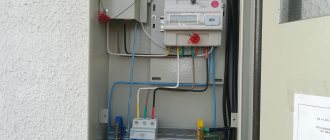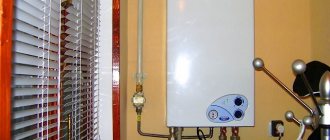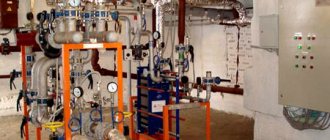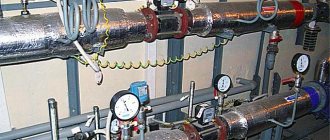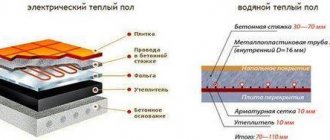The presence of central heating in the apartment is, of course, convenient, since the owners “don’t have a headache” in this regard. But, unfortunately, this is not always practical, since the temperature in the rooms begins to directly depend on the thermal regime established in the common boiler room. In addition, such a system is not insured against emergency situations that can occur along any part of its length, as a result of which the entire house is often turned off from heating. Many difficulties also arise during the “off-season” periods, when early cold weather arrives ahead of the planned start of the heating season, or, conversely, the radiators are heated when the weather outside is too warm.
Despite temperature violations and temporary heating shutdowns at home, payment for it remains unchanged, which is absolutely not beneficial for ordinary users. Therefore, in recent years, a trend has been gaining momentum when more and more owners of apartments in high-rise buildings are resorting to installing autonomous heating systems.
Individual heating in an apartment building - necessary documents and installation rules
Those who decide to “separate”, as a rule, have numerous questions related to various nuances of this procedure. Therefore, further we will consider individual heating in an apartment building - the necessary documents and installation rules for it.
Advantages and disadvantages of autonomous heating in an apartment
Before deciding on such a radical replacement, it is necessary to evaluate all the pros and cons of an individual heating system.
So, the advantages of having an autonomous heating system are as follows:
- The possibility of heating the apartment in the off-season, when the central system is not yet turned on or is already turned off, in accordance with established regional standards, which are based on the ambient temperature, is very unstable and with large daily fluctuations at these times of the year.
- The ability to maintain the required temperature in the rooms, which is much more difficult to organize with central heating, since it does not take into account the location of the apartment and the degree of its insulation. There is probably no need to explain that apartments located inside the house, and corner ones, and even exposed to the prevailing winter winds, still require a differentiated approach to heating. However, in order to balance consumption costs, payments for heat are charged equally, usually based on the area of the apartment.
The location of both the apartments themselves and the rooms in them can vary significantly, which also affects the need for heat.
With an autonomous heating system, this problem is easier to cope with. Therefore, having installed autonomous heating in apartments, you can and should immediately take into account the specifics of the location of the rooms, obtaining both a comfortable microclimate in any of them and considerable savings in money.
- Autonomous heating can be easily adjusted to individual operating modes. For example, there is no point in heating “to the fullest” if all the residents are absent at the moment. It would be more logical to only maintain the required level of heating. But by the time the owners arrive, the automation will “catch up” the heat so that the rooms have the optimal temperature.
Modern autonomous heating systems can be controlled remotely, for example, using a smartphone.
Many modern control systems are also capable of independently responding to changing weather conditions. They can also be controlled remotely using GSM or IP communication channels.
- A reduction in operating costs will also occur due to significantly lower energy consumption, since modern gas or electric equipment is designed for optimal energy consumption - they have high efficiency rates approaching 100 percent.
- When installing a double-circuit boiler, it is quite possible to abandon the central hot water supply system, providing your family with hot water autonomously. This means that an apartment equipped with such a unit will not depend on summer hot water maintenance work, and there will always be hot water.
With an autonomous heating system, you will have to pay only for the amount of energy actually consumed - according to the meter
- Another advantage can be attributed to the fact that you have to pay for central heating even in the summer, since it requires constant maintenance. Having installed an autonomous heating option, payments will be made only according to the gas (or electric) meter, that is, it will be possible to directly control energy consumption and costs for heating and hot water supply, carry out analysis and find ways to further save.
However, there are also considerable difficulties when switching an apartment to individual heating, and they can be attributed to the disadvantages of its arrangement:
- All work must be carried out legally and in compliance with all requirements necessary for this process. Unauthorized reconstruction, firstly, will not eliminate utility bills for heating and hot water supply. And secondly, it also threatens with serious administrative punishment in the form of a rather large fine.
- There will be difficulties associated with preparing documentation for disconnecting from central communications, developing a project, and obtaining permission to install equipment.
- It will be necessary to allocate or equip a room with a proper ventilation system for installing the heating unit.
- Installation of the system is a task of a fairly high complexity category.
- Considerable expenses will be required, both in paperwork and in purchasing everything necessary for the installation of autonomous heating and hot water supply. And this does not even take into account installation work.
- All responsibility for carrying out operational and preventive measures, as well as for the safety of the system, falls entirely on the owner of the apartment. It should be taken into account that all of the above-mentioned processes associated with autonomous heating will be controlled by the relevant specialized organizations, whose representatives the owner of the apartment will have to provide access to the installed equipment.
However, even taking into account all the upcoming difficulties and significant initial costs, an autonomous heating system is in all respects much more profitable than central heating and hot water supply. In practice, it will pay for itself quickly enough and will serve reliably for many years.
What is individual heating?
Autonomous heating in multi-storey buildings means a system in which the coolant is heated using gas or electric appliances. Therefore, interruptions in the supply of these energy sources will inevitably lead to a decrease in room temperature. And yet, at present, it is precisely such autonomous heating systems that are one of the most convenient and cost-effective ways to heat living space. Therefore, before installation, it is necessary to consider all aspects of their use.
A package of necessary documents for “autonomization”
In order to organize autonomous heating in an apartment, you will have to do some redevelopment, and this, as you know, is a rather labor-intensive process. It should be taken into account that the preparation of permitting documents can take from three to five months, and installation work can take about a week. In this regard, the preparation process must begin in advance.
All work on organizing autonomous gas heating of an apartment must be carried out exclusively in accordance with the developed and approved project
Preliminary approvals and obtaining permits
So, the first step is to decide on the documents that will be required in order to begin developing the project, purchasing equipment, and then installing an autonomous system. The list of documents is approved by Art. 26 of the Housing Code of the Russian Federation “Grounds for the reconstruction and (or) redevelopment of residential premises.”
Any reconstruction of residential premises is carried out taking into account the established requirements and in agreement with local authorities. For approval, it is necessary to collect a package of documents, which includes standard title documents for the ownership of this housing, which include the following:
- Application-petition for housing reconstruction. The application form is standard and approved by the Government of the Russian Federation.
- Certificate of state registration of ownership of the apartment - this may be the right of inheritance or an agreement on the transfer of ownership of housing. A copy of the document certified by a notary will be required.
- The technical passport for the apartment is a photocopy certified by a notary.
- An apartment redevelopment project, completed in accordance with the established form.
- A certified copy of a document indicating all persons registered in the apartment.
- Consent to the reconstruction of the heating system from all residents of the apartment. This document is drawn up on one sheet of paper, where all persons living in the apartment are listed, and then they put their signatures, confirming their consent.
- A document from the organization for the protection of architectural monuments, if the house where reconstruction is planned belongs to the category of architectural monuments.
To obtain permission to re-equip the heating system, you will have to collect a considerable package of documents.
The applicant should remember that self-government bodies do not have the right to demand other documents not provided for in this article. After accepting the package of documentation for consideration, the applicant must be issued a receipt with a list of accepted documents.
Next, the collected documents by the self-government organization are sent to the authority, where they must be approved. Most often, such issues are resolved in the city government administration.
Review and decision on consent or refusal must be carried out no later than 45 days from the date of submission of the documentation. The document developed by the commission must be issued to the applicant no later than 3 working days after the decision is made.
According to the norms and rules for the technical operation of housing, which were approved by the State Construction Committee of Russia No. 170 dated September 27, 2003, a refusal to redevelop or reconstruct a residential premises may follow if these actions worsen the living conditions of all or individual residents of the building where the applicant’s apartment is located.
However, that's not all. The list of documents indicates a redevelopment project, which must be approved by the gas and heat supply regulatory organizations, since permission must be obtained to disconnect from the central heating system and install gas equipment. And after receiving such permits, a project for redevelopment and installation of an autonomous system is drawn up, which must be agreed upon with the relevant authorities.
Therefore, it is necessary to prepare all the above documents, since they will have to be presented to all organizations that directly influence the preparation of the project. Documentation is completed in the following order:
- The first organization you need to contact is the city or district heating networks. It is there that permission is given to disconnect the apartment’s heating circuit from the central heating system. Consent can be issued if the shutdown does not lead to disruption of the engineering equipment of nearby apartments or the entire building. In principle, there cannot be any other reasons for refusal.
If an unfounded refusal is received from this organization, then this is a reason to go to the courts. It should be noted that sometimes an application for disconnection is submitted through the organization of self-government of the housing stock.
- Then, with the received letter of agreement, you must contact the gas service of the district or city to obtain technical conditions for the installation of autonomous heating. This document must be issued within 10 days from the date of the applicant’s application.
- After receiving the specifications, taking all the documentation for the apartment, you can go to a design or energy organization that is engaged in drawing up such projects. If the boiler was purchased before the project was drawn up, and it meets all the requirements for installation in an apartment in a multi-storey building, then documentation for it should also be provided to the design organization. The project will be prepared taking into account the provided technical conditions.
Most of the requirements imposed by regulatory organizations, including the gas service, are specified in the document “Heating, ventilation and air conditioning”, paragraph 6.2 “Apartment heat supply systems” SNiP41-01-2003.
To free yourself from going through all the authorities, you can entrust the preparation and approval of all necessary documents to the design organization. In some regions of Russia, this function is taken over by the gas service. Naturally, all this additional work comes at an additional cost.
Autonomous heating project
Separately, it is necessary to say about the heating reconstruction project. First of all, before contacting specialists who will carry out design work, you need to carefully study the technical conditions used in drawing up the project, and it is advisable to draw up a preliminary sketch of the approximate location of the heating elements.
The location of the heating boiler should be determined by design specialists, taking into account the wishes of the apartment owners, if this is permissible
Its exact location can be determined after specialists study the apartment plan, which is in the technical passport.
So, the project is a necessary document when carrying out any reconstruction of a residential premises. Based on it, a new heating circuit and heating boiler will be installed. How correctly and accurately this document is drawn up, and then the equipment is installed according to it, the more efficiently it will work.
The project includes data on external and internal factors that determine the type of heating:
- Climatic conditions of the region in which the house is located.
- Engineering and technical characteristics of the structure.
- Available energy sources on which the heating system can operate.
- Technical characteristics of heated housing - the number of rooms, the presence of loggias, as well as the area and volume of the premises.
- The financial side of the issue.
Based on these data, not only the installation location of the heating unit is selected, but also its type, as well as power.
To make heating efficient and economical, it is recommended to entrust the development of its design to specialists. This stage is best handled by energy companies that themselves control or interact with organizations that approve the heating sector, with whom the project will subsequently be coordinated, which will definitely ensure the correctness of its preparation, and therefore approval.
To obtain a positive result and an optimal technical solution, the customer must work closely with the organization developing the project. During the process of creating a project, several options are usually considered. The customer selects the one that suits him most, after which the technical parameters of the unit and all the necessary equipment are determined. The project is being developed in several stages:
- If the customer has not provided his own version of the sketch, then work begins with it.
- A heating circuit diagram is being developed, on the basis of which the system will be installed.
- Documentation for the designed heating system is being prepared.
- An estimate is drawn up.
If this work is entrusted to professionals, then at each specific stage of project development, specialists in the field of heat supply, ventilation, architecture, and energy supply will participate in it.
The project consists of several parts, which present certain data from different aspects of the project:
- The narrative part provides information about the content and significance of the project. This section of the document, in turn, is divided into several paragraphs, which contain the following technical data:
— location of the apartment or house, if autonomous heating is planned to be installed in the private sector;
— location of residential premises and layout features.
The descriptive section of the document clarifies the technical characteristics of the premises, taking into account their location and climatic characteristics of the region where the building is located. This description is necessary in order to determine the types and types of heating equipment. This information will subsequently be used to carry out calculations and determine the power that the heating system should have, as well as the temperature parameters in the apartment.
- Technological calculations are the main part of the project, which summarizes the parameters of the volume of the required energy carrier when the unit operates in different modes, as well as the optimal coolant temperature that provides the necessary heating of the apartment rooms. It is especially important to determine the power of the heating and hot water supply boiler, since on the basis of these calculations the selection of equipment and components for it is made.
In the same part, heat losses when heating rooms are calculated, on the basis of which it will be possible to draw conclusions about the efficiency of the system.
The calculated parameters will also show how appropriate this or that wiring is and the type of connection of radiators to the system circuit. The calculations also include the use of automatic control devices in the heating system.
Further, all the data obtained is necessarily reflected on the diagram of the heating system, which will become a guide for installers during the work. Deviations from the scheme developed by specialists and approved may lead to refusal to put the system into operation, which is permitted by the selection committee.
The project must take into account everything - from the power of the boiler and heat exchange devices to the diameter of the circuit distribution pipes
- Specification . This section contains data on the main materials and elements of the heating system, and their main technical characteristics. This part of the project also includes a diagram of the heating system with marked components and devices listed in the list.
The specification lists in detail the number and parameters of all components, elements and parts of the heating system.
This information is key to calculating the hydrostatics of the system, as well as the required heating temperature. If these calculations are carried out incorrectly, the system will be ineffective and gas consumption will be exceeded.
- A graphic representation is an important section of the project, which visually represents what the overall design of the heating system will look like. This part of the project is carried out using special computer programs, most often in three-dimensional projection.
The image clearly shows the location of the heating unit, pipeline and connecting nodes.
When submitting an application for project development, it is necessary to clarify for specialists the reasons for the transition to an autonomous type of heating. The more justification there is, the more accurate the calculations will be, since specialists will know what to pay special attention to when carrying out them.
A copy of the design documents must be submitted to the gas company, which will subsequently maintain the installed equipment.
How to obtain permission to install individual heating
It should be remembered that unauthorized interference with the operation of any engineering systems is prohibited, as this may violate the rights of other residents of the house to receive a particular utility service. This also applies to the centralized heating system. Therefore, when switching to autonomous heating of an apartment, it is necessary to obtain a number of permits. This procedure is not bureaucratic arbitrariness, as is commonly believed, but is dictated by the need to prevent violations of the hydraulic balance of the system, as well as to ensure technical, fire and environmental safety when operating gas or electrical equipment.
To obtain permission, the apartment owner must prepare the following documents:
- application in the approved form;
- original or notarized copy of the document on ownership of the apartment;
- photocopy of the technical passport;
- project for the installation of autonomous heating;
- if the house is classified as a historical and architectural monument, you need to obtain approval from the relevant government agency.
After obtaining permission, you can begin installation work, which must be performed exclusively by specialized services or private companies licensed to perform such services. When the work is completed, the apartment owner must again contact the city administration to draw up an acceptance certificate. Only after this can you begin operating the heating system.
Gas boiler for autonomous heating of an apartment
When drawing up a project, specialists will offer boiler options that can be used for installation in an individual apartment heating system. However, you need to independently study some information related to the choice of unit.
A boiler for autonomous heating of an apartment in a multi-storey building must strictly comply with certain criteria, mostly related to ensuring safe operation
First of all, you should refer to the Decree of the Government of the Russian Federation No. 307, paragraph 44 of April 16, 2012, which discusses the connection of heat supply systems. This resolution provides a list of heat and power devices that do not meet the established requirements and are therefore prohibited for installation in apartments of multi-storey buildings. After studying this document, you will be able to immediately decide which devices cannot be installed in the apartment’s autonomous heating system.
So, the list of boilers that can be used in apartments of multi-storey buildings includes units that operate on natural gas and meet the following requirements:
- Having a closed (sealed) combustion chamber.
- Mandatory automatic shutdown of the fuel supply in the event of a power outage, burner flame extinguishment, if there is a malfunction in the protection circuit, in case of insufficient pressure inside the system, which may fall below the limit value, when the coolant is heated above the limit temperature, as well as in case of problems in the smoke exhaust system .
- With the permissible coolant temperature in the system not exceeding 95˚.
- The coolant pressure is not more than 1 MPa.
In addition, boilers are single-circuit, used only for heating the apartment, and double-circuit, designed for both heating and water heating. When submitting an application and collecting documents, this factor must also be indicated. This is due to the fact that heating networks must give consent to disconnect the apartment not only from heating, but also from the hot water system.
For an apartment, the best option would be a wall-mounted boiler - it is compact, will not take up too much space and will fit perfectly into the interior of the room
Next, you need to decide on the design of the heating unit, since it can be wall-mounted or floor-mounted. For installation in a modern apartment, the wall-mounted version of gas equipment is most often chosen, since such boilers have compact sizes and a rather aesthetic design, resembling a gas water heater in appearance. Since the chimney pipe from the heating boiler must go outside, it will be convenient to place it on an external wall; with this installation there will be no problems with the location of the pipe in the room. As a rule, there is a window on the external wall that will solve problems with ventilation of the room. Typically, the power of a wall-mounted boiler is sufficient to heat a standard apartment with proper insulation of the walls and the presence of Euro-windows with double-glazed windows.
Premises in the apartment where a gas boiler can be installed
Separately, a few words need to be said about the room for installing a gas boiler, since it will not be possible to place it in any room, according to the owners’ preference.
There are a number of important requirements for the room where the gas boiler will be located.
The room for placing gas heating equipment must meet certain safety requirements, which include the following:
- Gas equipment must not be installed in a residential area.
- The area of the room must be no less than 4 square meters.
- The entrance door to the room with the installed boiler must have a width of at least 800 mm.
- The room must be equipped with a window facing the street.
- The boiler is mounted on the wall or installed on the floor, at a distance that must be at least 300 mm from other gas equipment, for example, a gas stove.
- Indoors, it is necessary to find the possibility of venting the chimney to the street, that is, through the wall. Exiting the pipe into a common house ventilation duct is not allowed.
- Some heating units require forced ventilation in the room, that is, you will have to install an exhaust fan on the window. This will be indicated in the technical specifications.
- A wall-mounted boiler must be mounted on a wall built of non-combustible material, and for a floor-standing boiler it is necessary to make a fire-resistant flooring, for example, lay ceramic floor tiles.
Without fulfilling these requirements, the commission signing the acceptance certificate will not give its consent to the commissioning of an autonomous heating system.
Based on the characteristics of the room, we can conclude that the unit can be installed in the kitchen or in a pre-insulated loggia combined with it. Since the gas boiler is connected to the main energy supply pipeline, which is connected to the kitchen area of the apartment, it is this that is optimal for the location of the heating unit.
For all reasons, it is the kitchen that becomes the optimal, and very often, simply the only possible option for placing a gas heating boiler
In addition, the kitchen must be equipped with a window facing the street and a door of the required width. And, in addition, a general house ventilation channel is connected to it, which is also necessary for placing an apartment “boiler room”.
How to choose a gas heating boiler?
In order for the purchased boiler to fully meet the parameters of the heating system being created, to be reliable and easy to use, it is necessary to be guided by a number of criteria for evaluating such equipment when purchasing. How to choose a gas boiler - read in a separate publication on our portal.
Letter of the law: no amateur performances
It is strictly prohibited to carry out such a complex reconstruction as the installation of an individual heating system without approval or even with minimal “deviations” from the project. Such amateur activity entails a fine. And, one way or another, you will have to return the living space to its previous condition within the prescribed period. If you do not want to incur double losses and get into trouble with the law, carry out all work exclusively in accordance with the available documentation.
Calculation of individual heating for an apartment should be carried out only by qualified specialists. The selection of equipment is carried out on the basis of the climatic characteristics of the region, heat loss of premises, room area, etc. - you are unlikely to be able to objectively take into account all the factors yourself
Autonomous electric heating
Installing electric heating is much simpler than gas heating. If only because there is a wider choice of where to install the boiler or other equipment, since the power supply is distributed throughout the apartment, and ventilation and a combustion product removal system are not required.
When planning the installation of electric heating, first of all, you need to consult the Energonadzor institution (or a similar organization). It is necessary to check the availability of resources in the house for the release of additional energy. If written consent has been received from this organization, then you must contact the heating network service with it and with a request to disconnect the apartment from the centralized heating supply.
The list of remaining documentation should be clarified with the energy company and local government authorities. The fact is that when installing electric heating in different regions of the country, the requirements for its installation may vary significantly. The only thing that needs to be noted is that the number of documents and approvals will be much less compared to the gas option for heating the apartment.
Thanks to modern technologies, today you can choose one of two options for electric heating. One involves the use of a heating unit with conventional piping for coolant circulation. The second involves direct heating by separately installed devices or systems - electric convectors, infrared heaters, underfloor heating systems.
Heating using an electric boiler
The system uses coolant, that is, the pipework and radiators remain in place. But they are connected to an electric heating boiler, and the coolant will be heated from it, and not from the central heating line.
Electric boiler - much easier to install, but requires a dedicated power line of the required power
Most modern models of electric heating units are equipped with automatic control. Therefore, the system can be programmed so that the heating of the premises to the required temperature does not occur constantly, but only at the time set by the owners. You can save a lot on this function, for example, by using the nightly reduced tariff to “charge” the heat accumulator.
On sale are wall-mounted electric boilers, which can have a power of 5–60 kW, as well as floor-standing options, their power exceeds 60 kW.
Experts will tell you which one to choose when submitting documents for drawing up a project for an electric heating system, which will contain a diagram of its arrangement. The choice of boiler will depend on the area and location of the apartment in the house, the degree of its insulation, the number of windows and balconies, as well as the material used to make the frames. Usually, when choosing a boiler power, they rely on established technological standards, that is, 1 kW of electricity per 10 “squares” of area.
We must not lose sight of the fact that if a unit with a power exceeding 9 kW is purchased, then there will be a need to re-equip the apartment electrical network and install a three-phase meter. If you plan to install a heating boiler with a larger capacity, then before purchasing it, you must consult and obtain written permission from the local energy company.
It should be taken into account that household electric boilers are not designed for a large number of radiators; therefore, their installation is optimal for heating small areas, up to 80 - 90 m². In addition to the boiler, “warm floor” systems can be used, which consume electricity quite economically.
Electric units operate according to a standard automatic heating system. The coolant (water or antifreeze) is heated as it passes through the boiler and then enters the heating circuit with radiators installed in it. Along this path, the coolant cools down and returns to the boiler for heating, etc. To make the circulation more intense and the radiators to warm up faster, a circulation pump is installed in the heating circuit.
An electric boiler, unlike gas equipment, can be installed in any utility room where it is convenient to install the power line, and from where it will be easier to carry out the general wiring of the heating circuit pipes. Most often, a kitchen or bathroom is also chosen for this. But sometimes it is also installed in the corridor, recessing the circuit pipe distribution into the wall surfaces.
What is an electric heating boiler?
The variety of such devices is quite large, not only in size, power and other operational parameters, but even in terms of heating principle. Read more about this in the special article on our portal dedicated to electric heating boilers .
Direct space heating with electrical appliances
Heating using separate electrical appliances or a “warm floor” system, which can be combined or work separately, is called a direct heating system.
Electric convectors sometimes become an excellent alternative to conventional heating batteries
This option is preferable to choose if there is a desire to get rid of numerous pipes and volumetric radiators, since, for example, electric convectors have a more aesthetic appearance and compact size. The “warm floor” system can be cable rod or film - but in any case, it is completely invisible to the eye.
When combining individual devices into a single system, it is possible to connect it to a common control unit, with the help of which temperature conditions are set by time of day and day of the week, taking into account the family’s daily routine.
Installation of film infrared “warm floor”
When choosing any type of electric heating, for safety reasons it is necessary to provide grounding, without which permission to put the system into operation will not be issued.
The advantage of electric heating is that, unlike gas heating, it is safer. And compared to the central system, it can be easily and very accurately adjusted, setting the required temperature.
The main disadvantage of the electrical system is that if there is a power outage, the apartment will be left not only without lighting, but also without heating. Therefore, if in a particular locality this phenomenon repeats itself with frightening consistency, then it is better to opt for autonomous gas heating of the apartment. In addition, the obvious “disadvantages” include very high electricity tariffs.
Features of the arrangement of electric heating lie in the observance of certain conditions that are not provided for the gas heating option. So, experts recommend:
- Run a separate power cable for the electric heating system from the distribution board, which will stabilize the load on the general house electrical network.
- RCD systems are installed today in all apartments of new buildings equipped with autonomous electric heating. If it is not there, then you will have to worry about purchasing such a block. This is reliable protection against electric shock when it leaks onto the device body.
- It is highly desirable to install a two-tariff meter, which will help save money if the heat supply to the premises occurs during preferential hours.
Devices and systems for direct space heating – what to choose?
The variety of such devices is extremely wide. You can take a closer look at energy-saving heaters Another publication will tell in detail about the types and specific features of various electric “warm floor” .
How can heat supply be provided to multi-apartment residential buildings?
There are two options - to power the heat pipes from the main heating networks or to install an autonomous heating point.
Modern technologies make it possible to provide autonomous heating for a house with many apartments.
Both options are good, but having an individual heating point for several apartment buildings and autonomous heating using energy-saving means will please you more. Why?
Because the distance between the “heating point - consumer” pair is minimized, thereby reducing heat losses along the heating network line. This type of heating is called decentralized or autonomous.
Pros:
A lower percentage of costs for heating and hot water supply of an apartment building - and all because the costs of transportation and delivery of coolant to the end consumer are reduced.
Simply put, the heat supply source is practically nearby, which reduces both the time it takes to supply heat to residential buildings and the percentage of heat losses. This results in a reduction in the costs of maintenance, service and repair of heating systems.
The efficiency of heat supply systems – as a consequence, follows from the previous factor. Since the source of heat supply is nearby, the cost of utility bills for hot water supply and heating is somewhat lower.
Independence from the citywide heating schedule. In other words, while heating has not yet been provided in the city (“because the heating season has not arrived as scheduled”), and the temperature outside is already low, apartment-by-apartment heating from an autonomous heat source will come in very handy.
In addition, each consumer will be able to select the optimal temperature conditions for his apartment - turn off/turn on the heating system only for his apartment, adjusting the level of heat supply.
Lower cost and higher return on investment for new buildings with an autonomous heat supply source.
A separate boiler room in each house will increase the free space in the yard. Click to enlarge.
The presence of “additional free space” within the entire microdistrict. This also contributes to the implementation of housing programs, the construction of new buildings and the development of microdistricts not for heating mains, but for the infrastructure of the districts.
In addition, providing apartment buildings with an autonomous source of heat supply is also possible if the construction area already has an established gas supply system.
Flaws
However, along with the advantages that consumers of decentralized heating and hot water have, there are a number of disadvantages:
- The need for additional space allocated for the construction of an autonomous boiler house.
- Unecological operation of the boiler room. For a gas boiler house operating autonomously, it will be necessary to additionally equip an exhaust gas removal system in order to reduce smoke emissions into the atmosphere as much as possible, obtaining the MPC (maximum permissible concentration) value required by SNiP.
- Price. Since autonomous heating today is not yet as popular and in demand as centralized heating systems, the production of boiler equipment for it has not been put on the conveyor belt. Consequently, prices for decentralized heating and hot water systems are still high.
Is it possible to eliminate the above disadvantages completely or at least reduce them to a minimum? Can. Additional space for an autonomous boiler room can be “found” on the roof of a multi-story building that will be heated.
An increasing number of new buildings are already equipped with a roof boiler room with equipment installed on top and overhead piping.
Of course, the installation of additional equipment will cost, and the decentralized heat supply itself to one apartment building is not cheap, but it will all pay off faster than if the house was simply connected to a centralized heat supply system.
Installation of an autonomous heating system
Disconnecting an apartment from the central heating and hot water supply lines, as well as installing a gas and electric boiler, is carried out only by specialists from energy companies who have a special documented permit to carry out such work.
Connecting and starting heating equipment is always trusted only to qualified specialists
Such rules have been introduced to comply with all safety conditions both during installation and during operation of the equipment. We must not forget that in an apartment building there are many neighboring apartments with people in them. And you shouldn’t put your life and theirs in danger.
You can take on the laying of pipes and the placement of heating radiators, as well as the installation of other necessary elements of the system. But even then only if you have good skills in carrying out such operations.
In this publication, there is little point in dwelling on the installation order. The fact is that all the details are set out in a special article on the portal.
Nuances of installing a water heating system
Whether a gas boiler is installed or an electric one, otherwise the wiring of the pipe circuit, installation of radiators, additional devices and parts are almost the same. How to install a heating system in a house or apartment - the recommended link will lead you to the corresponding detailed instructions.
* * * * * * *
Before deciding to abandon centralized heating and hot water supply, you need to weigh all the positive and negative aspects of autonomous heating of the apartment. And only after carrying out such a comparison and conducting a thoughtful analysis should we begin collecting documents.
One more small clarification. It may also happen that, having disconnected the apartment from the heat supply and hot water supply, you will still have to pay for general heating. But these amounts will be quite miniscule compared to those that were previously indicated in the monthly payment order.
And finally, a short video that will also help you weigh all the “pros” and “contras” of an autonomous heating system in an apartment


